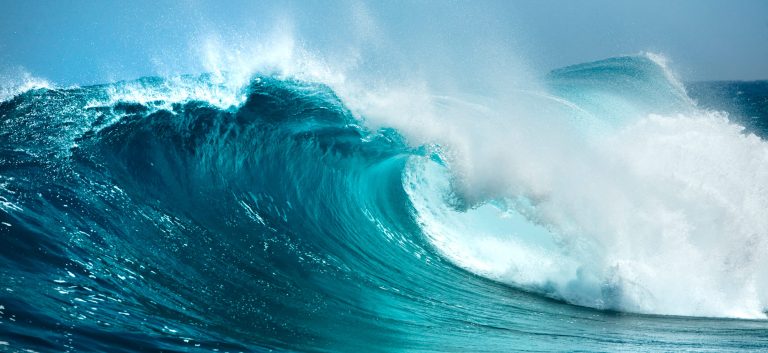
Did you ever stop and wonder about the vast potential that lies within our oceans? We, too, were curious to explore this topic and discover how ocean energy can positively impact our lives. From generating clean electricity to providing sustainable solutions, the possibilities seem endless. In this article, we will delve into the fascinating world of ocean energy and explore how harnessing this powerful force can benefit us all.
When it comes to our oceans, they are not merely bodies of water but hold an immense amount of untapped energy. By utilizing this energy, we can reduce our reliance on traditional sources such as fossil fuels and transition towards a more sustainable future. Wave energy, tidal energy, and thermal energy are just a few examples of the incredible potential that lies beneath the surface.
We understand that the concept of ocean energy may seem complex, but fear not! In this article, we’ll break down the various types of ocean energy and explain how they work. We’ll also delve into the exciting developments in this field, showcasing how Ireland, with its rich coastline, can fully embrace and benefit from the immense power of the ocean. Curious to learn more? Then read on and join us in exploring the vast possibilities offered by ocean energy.
Overview of Ocean Energy
Ocean energy refers to the energy derived from the waves, tides, currents, and temperature differences in the ocean. It is a renewable and sustainable source of energy that has gained significant attention in recent years. Harnessing the power of the ocean’s natural forces can provide a clean and abundant energy solution, contributing to a greener future.
Definition of Ocean Energy
Ocean energy encompasses various technologies and methods used to convert the energy in oceanic processes into usable forms of power. These processes include wave energy, tidal energy, ocean currents, and thermal energy. The energy is captured and converted into electricity, which can be used to power homes, industries, and other applications.
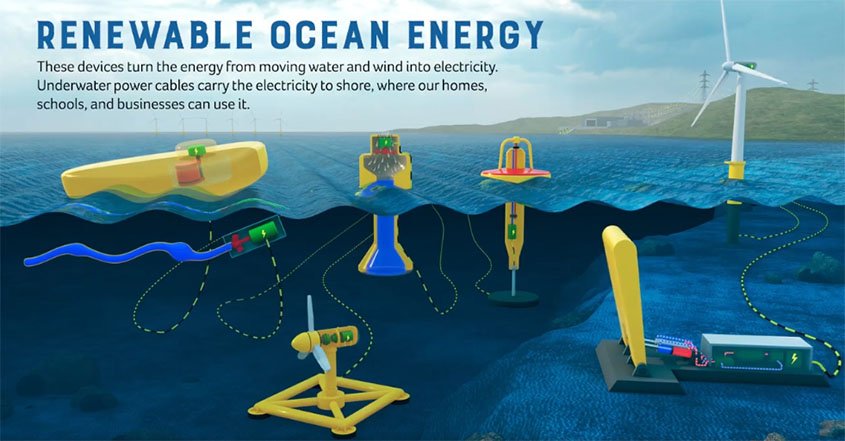
Importance of Ocean Energy
Ocean energy has immense importance in the context of sustainable energy development. As the world continues to grapple with climate change and the depletion of fossil fuels, alternative energy sources like ocean energy have become crucial. Harnessing ocean energy can reduce our reliance on fossil fuels, minimize carbon emissions, and help combat climate change. Furthermore, it can enhance energy security and create new economic opportunities for coastal communities.
Types of Ocean Energy Sources
There are different types of ocean energy sources that can be harnessed for electricity generation:
-
Wave Energy: This involves converting the kinetic energy from ocean waves into electricity through various devices, such as wave buoys or oscillating water columns.
-
Tidal Energy: Tidal energy is generated by harnessing the power of the tides, which occur due to the gravitational pull of the moon and sun. Tidal turbines or tidal barrages are used to capture this energy.
-
Ocean Currents: Ocean currents, such as the Gulf Stream or Kuroshio Current, can be utilized to generate electricity using underwater turbines placed in areas with strong currents.
-
Thermal Energy: Thermal energy is derived from the temperature difference between the ocean’s surface and deeper waters. This temperature gradient can be utilized through technologies like Ocean Thermal Energy Conversion (OTEC).
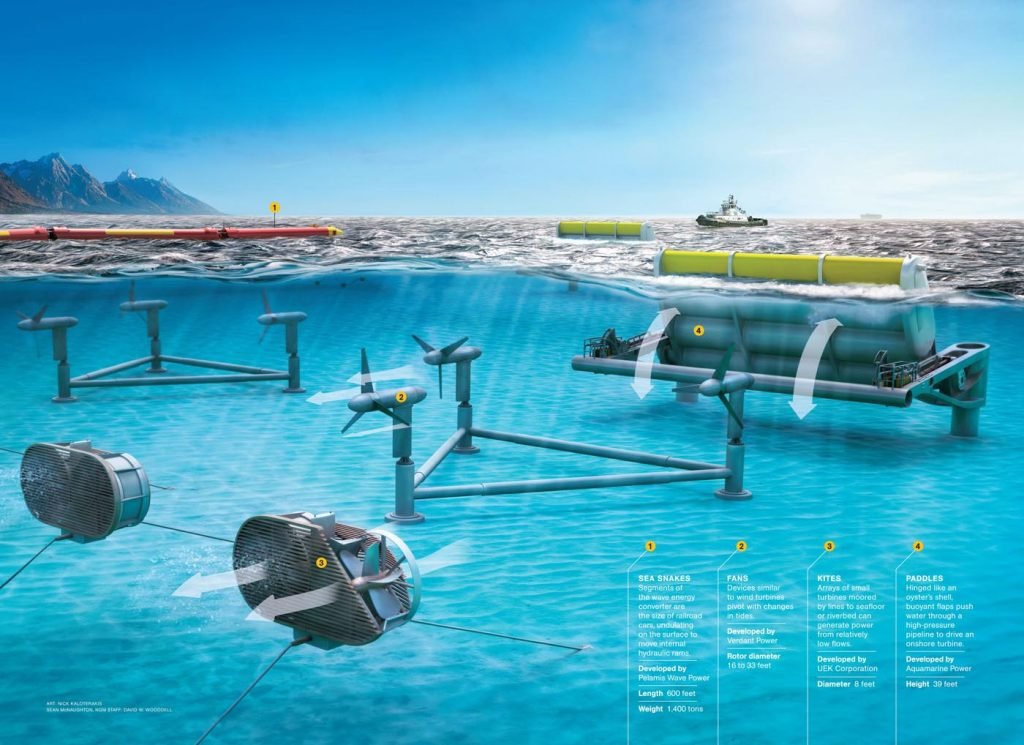
Harnessing Ocean Energy
Harnessing ocean energy requires the development of dedicated infrastructure and the use of specialized technologies. The construction of necessary infrastructure involves offshore installations and, in some cases, onshore facilities for energy transmission and distribution. This includes the installation of wave energy converters, underwater turbines, tidal barrages, and OTEC systems.
Various technologies are used to capture and convert ocean energy:
-
Wave Energy Converters (WECs): These devices work by harnessing the motion of waves in the ocean and converting it into electricity. WECs can be either floating devices on the water’s surface or submerged beneath the ocean.
-
Tidal Turbines: Tidal turbines are similar to wind turbines but are specifically designed to capture the kinetic energy of tidal currents. They have rotors that are driven by the movement of the tides, generating electricity.
-
OTEC Systems: OTEC systems use the temperature difference between the warm surface waters and the colder deep waters of the ocean. This temperature gradient is used to create steam that drives a turbine, producing electricity.
Advantages of Ocean Energy
Ocean energy offers several advantages, making it a promising alternative to conventional energy sources:
-
Renewable and Sustainable Nature: The beauty of ocean energy lies in its renewable and sustainable characteristics. Unlike fossil fuels, the ocean’s energy is naturally replenished and does not produce greenhouse gas emissions during the generation process.
-
Abundance of Ocean Energy Potential: The world’s oceans contain enormous energy potential, with waves, tides, and currents constantly in motion. This abundance makes ocean energy a reliable and accessible resource.
-
Low Environmental Impact: Compared to traditional energy sources like coal or oil, ocean energy has a significantly lower environmental impact. The energy conversion processes do not produce harmful emissions or pollutants, and their infrastructure has minimal visual impact.
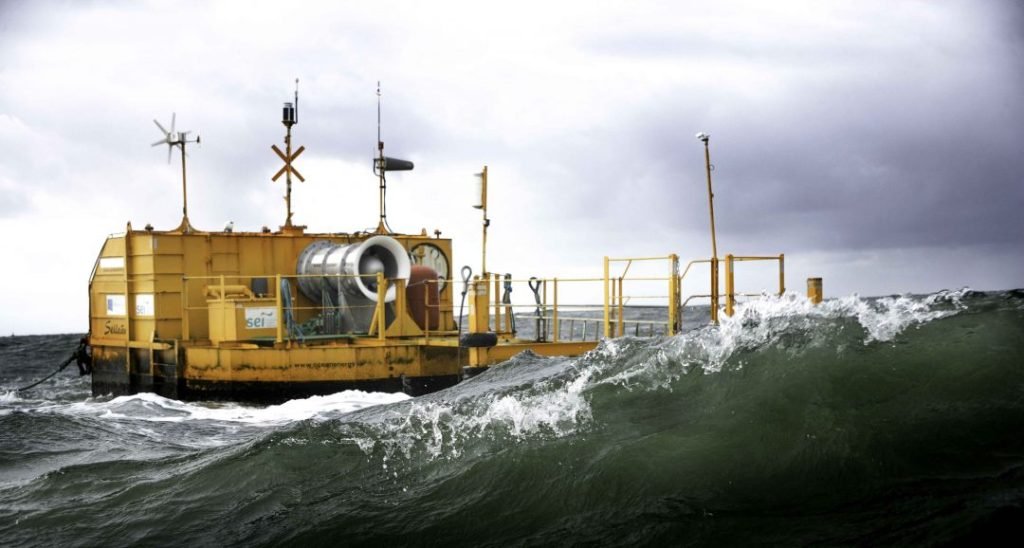
Current Status of Ocean Energy
Globally, the development of ocean energy is gaining momentum, with several countries leading the way in research, deployment, and production:
-
Global Trends in Ocean Energy Development: Many countries, including the United Kingdom, France, China, and Australia, have invested in ocean energy projects. Governments, research institutions, and private companies are collaborating to develop cutting-edge technologies and create a policy framework that supports ocean energy deployment.
-
Leading Countries in Ocean Energy Production: Scotland, a world leader in the field, has successfully deployed various wave and tidal energy projects, generating power for communities. Other countries, such as Canada, the United States, South Korea, and Norway, are also actively exploring and developing ocean energy resources.
Ocean Energy Usage in Ireland
Ireland, with its abundant marine resources and favorable geographical location, has great potential for ocean energy utilization:
-
Benefits for Ireland: Embracing ocean energy can bring substantial benefits to Ireland’s energy system and society as a whole. It can enhance energy security, reduce carbon emissions, create green jobs, and stimulate economic growth in coastal areas.
-
Policies and Support for Ocean Energy in Ireland: The Irish government has prioritized ocean energy in its renewable energy target. Various policies, grants, and funding schemes have been established to support the development and commercialization of ocean energy technologies.
-
Potential Applications in Various Sectors: Ocean energy can be integrated into various sectors, such as electricity generation, desalination, aquaculture, and offshore industries. Its versatility offers opportunities for innovation and diversification in Ireland’s energy landscape.

Challenges and Limitations
Despite the immense potential of ocean energy, several challenges and limitations need to be addressed for its large-scale deployment:
-
Technical Challenges in Harnessing Ocean Energy: Developing robust and efficient technologies that can withstand harsh marine environments remains a significant challenge. Innovations are needed to improve device designs, energy conversion efficiency, and materials used.
-
Economic Limitations: The initial capital costs of ocean energy projects are high, making them economically challenging. Cost reduction strategies, such as research collaborations, technological advancements, and policy support, are crucial to make ocean energy commercially viable.
-
Environmental Concerns: Although ocean energy has a low environmental impact compared to fossil fuels, it is essential to consider potential effects on marine ecosystems. Proper site selection, monitoring, and mitigation measures are necessary to minimize any adverse ecological consequences.
Future Outlook
The future of ocean energy looks promising, with ongoing research and development efforts aimed at overcoming current challenges and maximizing its potential:
-
Research and Development in Ocean Energy: Governments, research institutions, and industry stakeholders are investing in R&D to improve device performance, increase energy conversion efficiency, and enhance the reliability and durability of ocean energy technologies.
-
Expected Growth and Advancements: As technological advancements continue, the cost-effectiveness of ocean energy is expected to improve. With increased deployment and scale, ocean energy has the potential to become a mainstream renewable energy source.
-
Integration with Other Renewable Sources: Synergies between ocean energy and other renewables like wind and solar power can enhance the overall energy mix. Integrated solutions that combine multiple renewable sources can help meet the growing energy demand sustainably.
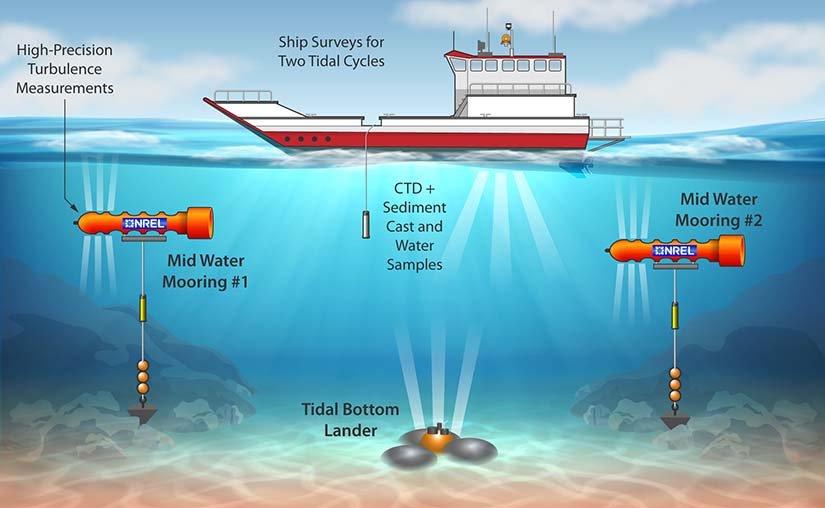
Case Studies of Ocean Energy Projects
Several notable ocean energy projects have been successfully deployed worldwide, showcasing the potential of this renewable energy source. Some examples include:
-
MeyGen Tidal Array, Scotland: The MeyGen tidal project, located in Scotland’s Pentland Firth, is one of the largest tidal energy projects globally. It harnesses tidal currents through underwater turbines, generating clean electricity for up to 175,000 homes.
-
Wave Hub, England: The Wave Hub project in Cornwall, England, serves as a test facility for wave energy technologies. It provides developers with grid-connected infrastructure to demonstrate the commercial viability of their wave energy devices.
Community Engagement and Awareness
Community engagement and raising awareness about ocean energy are crucial for its successful integration into the energy landscape:
-
Educational Initiatives and Public Outreach: Educational programs and public outreach initiatives can help increase understanding and knowledge about ocean energy. These efforts can be targeted towards schools, communities, and policymakers to promote engagement and support for ocean energy projects.
-
Promoting Awareness and Understanding of Ocean Energy: Communication campaigns, workshops, and site visits can create opportunities for the public to learn firsthand about ocean energy and its benefits. Building trust, answering questions, and addressing concerns are essential for gaining public acceptance.
Conclusion
Ocean energy holds significant potential for Ireland to harness its marine resources and transition to a sustainable energy future. By exploiting the power of waves, tides, and currents, we can reduce our greenhouse gas emissions, enhance energy security, and create a cleaner and greener environment. Embracing ocean energy requires collaboration, innovation, and policy support. It is time for Ireland to seize the opportunity and embrace the immense potential of ocean energy to improve our quality of life and ensure a sustainable future. Let us work together for a brighter and greener Ireland.